Early life
Picasso was born at 23:15 on 25 October 1881, in the city of Málaga, Andalusia, in southern Spain. He was the first child of Don José Ruiz y Blasco (1838-1913) and María Picasso y López. Picasso's family was of middle-class background. His father was a painter who specialized in naturalistic depictions of birds and other game. For most of his life, Ruiz was a professor of art at the School of Crafts and a curator of a local museum.
Picasso's birth certificate and the record of his baptism include very long names, combining those of various saints and relatives. Ruiz y Picasso were his paternal and maternal surnames, respectively, per Spanish custom. The surname "Picasso" comes from Liguria, a coastal region of north-western Italy. Pablo's maternal great-grandfather, Tommaso Picasso, moved to Spain around 1807.
Picasso showed a passion and a skill for drawing from an early age. According to his mother, his first words were "piz, piz", a shortening of lápiz, the Spanish word for "pencil". From the age of seven, Picasso received formal artistic training from his father in figure drawing and oil painting. Ruiz was a traditional academic artist and instructor, who believed that proper training required disciplined copying of the masters, and drawing the human body from plaster casts and live models. His son became preoccupied with art to the detriment of his classwork.
The family moved to A Coruña in 1891, where his father became a professor at the School of Fine Arts. They stayed for almost four years. On one occasion, the father found his son painting over his unfinished sketch of a pigeon. Observing the precision of his son's technique, an apocryphal story relates, Ruiz felt that the thirteen-year-old Picasso had surpassed him, and vowed to give up painting, though paintings by him exist from later years.
City of Málaga, Picasso's birthplace:
In 1895, Picasso was traumatized when his seven-year-old sister, Conchita, died of diphtheria. After her death, the family moved to Barcelona, where Ruiz took a position at its School of Fine Arts. Picasso thrived in the city, regarding it in times of sadness or nostalgia as his true home. Ruiz persuaded the officials at the academy to allow his son to take an entrance exam for the advanced class. This process often took students a month, but Picasso completed it in a week, and the jury admitted him, at just 13. As a student, Picasso lacked discipline but made friendships that would affect him in later life. His father rented a small room for him close to home so he could work alone, yet he checked up on him numerous times a day, judging his drawings. The two argued frequently.
Picasso's father and uncle decided to send the young artist to Madrid's Real Academia de Bellas Artes de San Fernando, the country's foremost art school. At age 16, Picasso set off for the first time on his own, but he disliked formal instruction and stopped attending classes soon after enrollment. Madrid held many other attractions. The Prado housed paintings by Diego Velázquez, Francisco Goya, and Francisco Zurbarán. Picasso especially admired the works of El Greco; elements such as his elongated limbs, arresting colours, and mystical visages are echoed in Picasso's later work.
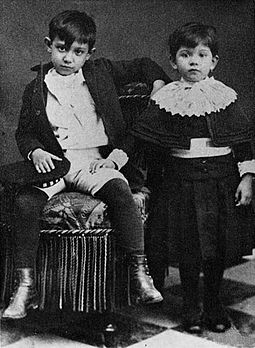
Picasso with his sister Lola, 1889.
Career
Picasso's training under his father began before 1890. His progress can be traced in the collection of early works now held by the Museu Picasso in Barcelona, which provides one of the most comprehensive extant records of any major artist's beginnings. During 1893 the juvenile quality of his earliest work falls away, and by 1894 his career as a painter can be said to have begun. The academic realism apparent in the works of the mid-1890s is well displayed in The First Communion (1896), a large composition that depicts his sister, Lola. In the same year, at the age of 14, he painted Portrait of Aunt Pepa, a vigorous and dramatic portrait that Juan-Eduardo Cirlot has called "without a doubt one of the greatest in the whole history of Spanish painting."
In 1897, his realism began to show a Symbolist influence, for example, in a series of landscape paintings rendered in non-naturalistic violet and green tones. What some call his Modernist period (1899-1900) followed. His exposure to the work of Rossetti, Steinlen, Toulouse-Lautrec and Edvard Munch, combined with his admiration for favourite old masters such as El Greco, led Picasso to a personal version of modernism in his works of this period.
Picasso made his first trip to Paris, then the art capital of Europe, in 1900. There, he met his first Parisian friend, journalist and poet Max Jacob, who helped Picasso learn the language and its literature. Soon they shared an apartment; Max slept at night while Picasso slept during the day and worked at night. These were times of severe poverty, cold, and desperation. Much of his work was burned to keep the small room warm. During the first five months of 1901, Picasso lived in Madrid, where he and his anarchist friend Francisco de Asís Soler founded the magazine Arte Joven (Young Art), which published five issues. Soler solicited articles and Picasso illustrated the journal, mostly contributing grim cartoons depicting and sympathizing with the state of the poor. The first issue was published on 31 March 1901, by which time the artist had started to sign his work Picasso. From 1898 he signed his works as "Pablo Ruiz Picasso", then as "Pablo R. Picasso" until 1901. The change does not seem to imply a rejection of the father figure. Rather, he wanted to distinguish himself from others; initiated by his Catalan friends who habitually called him by his maternal surname, much less current than the paternal Ruiz.
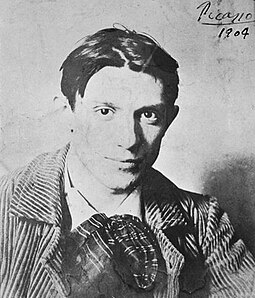
Pablo Picasso, 1904, Paris.
Political views
Picasso remained aloof from the Catalan independence movement during his youth, despite expressing general support and being friendly with activists within it. He did not join the armed forces for any side or country during World War I, the Spanish Civil War, or World War II. As a Spanish citizen living in France, Picasso was under no compulsion to fight against the invading Germans in either world war. In 1940, he applied for French citizenship, but it was refused on the grounds of his "extremist ideas evolving towards communism". This information was not revealed until 2003.
At the start of the Spanish Civil War in 1936, Picasso was 54 years of age. Soon after hostilities began, the Republicans appointed him "director of the Prado, albeit in absentia", and "he took his duties very seriously", according to John Richardson, supplying the funds to evacuate the museum's collection to Geneva. The war provided the impetus for Picasso's first overtly political work. He expressed anger and condemnation of Francisco Franco and fascists in The Dream and Lie of Franco (1937), which was produced "specifically for propagandistic and fundraising purposes". This surreal fusion of words and images was intended to be sold as a series of postcards to raise funds for the Spanish Republican cause.
In 1944, Picasso joined the French Communist Party. He attended the 1948 World Congress of Intellectuals in Defense of Peace in Poland, and in 1950 received the Stalin Peace Prize from the Soviet government. A portrait of Joseph Stalin made by Picasso in 1953 drew Party criticism due to being insufficiently realistic, though he remained a loyal member of the Communist Party until his death. His dealer, D-H. Kahnweiler, a socialist, termed Picasso's communism "sentimental" rather than political, saying "He has never read a line of Karl Marx, nor of Engels of course." In a 1945 interview with Jerome Seckler, Picasso stated: "I am a Communist and my painting is Communist painting. ... But if I were a shoemaker, Royalist or Communist or anything else, I would not necessarily hammer my shoes in a special way to show my politics." His commitment to communism, common among continental intellectuals and artists at the time, has long been the subject of some controversy; a notable demonstration thereof was a quote by Salvador Dalí (with whom Picasso had a rather strained relationship):
Picasso es pintor, yo también; ... Picasso es español, yo también; Picasso es comunista, yo tampoco.
(Picasso is a painter, so am I; ... Picasso is a Spaniard, so am I; Picasso is a communist, neither am I.)
In the late 1940s, his old friend surrealist poet André Breton, who was a Trotskyist and anti-Stalinist, was more blunt; refusing to shake hands with Picasso, he told him: "I don't approve of your joining the Communist Party nor with the stand you have taken concerning the purges of the intellectuals after the Liberation." As a communist, Picasso opposed the intervention of the United Nations and the United States in the Korean War, and depicted it in Massacre in Korea. The art critic Kirsten Hoving Keen wrote that it was "inspired by reports of American atrocities" and considered it one of Picasso's communist works.
On 9 January 1949, Picasso created Dove, a black and white lithograph. It was used to illustrate a poster at the 1949 World Peace Council and became an iconographic image of the period, known as "The dove of peace". Picasso's image was used around the world as a symbol of the Peace Congresses and communism.
In 1962, he received the Lenin Peace Prize. Biographer and art critic John Berger felt his talents as an artist were "wasted" by the communists. According to Jean Cocteau's diaries, Picasso once said to him in reference to the communists: "I have joined a family, and like all families, it's full of shit."
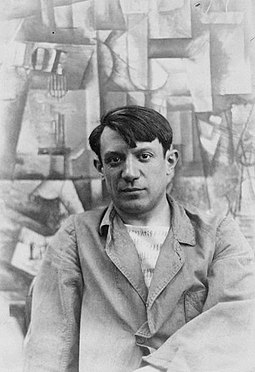
Picasso in front of his painting The Aficionado at Villa les Clochettes, summer 1912.
Style and technique
Picasso was exceptionally prolific throughout his long lifetime. At his death there were more than 45,000 unsold works in his estate, comprising 1,885 paintings, 1,228 sculptures, 3,222 ceramics, 7,089 drawings, 150 sketchbooks, many thousands of prints, and numerous tapestries and rugs. The most complete - but not exhaustive - catalogue of his works, the catalogue raisonné compiled by Christian Zervos, lists more than 16,000 paintings and drawings. Picasso's output was several times more prolific than most artists of his era; by at least one account, American artist Bob Ross is the only one to rival Picasso's volume, and Ross's artwork was designed specifically to be easily mass-produced quickly.
The medium in which Picasso made his most important contribution was painting. In his paintings, Picasso used colour as an expressive element, but relied on drawing rather than subtleties of colour to create form and space. He sometimes added sand to his paint to vary its texture. A nanoprobe of Picasso's The Red Armchair (1931), in the collection of the Art Institute of Chicago, by physicists at Argonne National Laboratory in 2012 confirmed art historians' belief that Picasso used common house paint in many of his paintings. Much of his painting was done at night by artificial light.
Picasso's early sculptures were carved from wood or modelled in wax or clay, but from 1909 to 1928 Picasso abandoned modelling and instead made sculptural constructions using diverse materials. An example is Guitar (1912), a relief construction made of sheet metal and wire that Jane Fluegel terms a "three-dimensional planar counterpart of Cubist painting" that marks a "revolutionary departure from the traditional approaches, modeling and carving".
From the beginning of his career, Picasso displayed an interest in subject matter of every kind,[109] and demonstrated a great stylistic versatility that enabled him to work in several styles at once. For example, his paintings of 1917 included the pointillist Woman with a Mantilla, the Cubist Figure in an Armchair, and the naturalistic Harlequin (all in the Museu Picasso, Barcelona). In 1919, he made a number of drawings from postcards and photographs that reflect his interest in the stylistic conventions and static character of posed photographs. In 1921 he simultaneously painted several large neoclassical paintings and two versions of the Cubist composition Three Musicians (Museum of Modern Art, New York; Philadelphia Museum of Art). In an interview published in 1923, Picasso said, "The several manners I have used in my art must not be considered as an evolution, or as steps towards an unknown ideal of painting ... If the subjects I have wanted to express have suggested different ways of expression I have never hesitated to adopt them."
Although his Cubist works approach abstraction, Picasso never relinquished the objects of the real world as subject matter. Prominent in his Cubist paintings are forms easily recognized as guitars, violins, and bottles. When Picasso depicted complex narrative scenes it was usually in prints, drawings, and small-scale works; Guernica (1937) is one of his few large narrative paintings.
Picasso painted mostly from imagination or memory. According to William Rubin, Picasso "could only make great art from subjects that truly involved him ... Unlike Matisse, Picasso had eschewed models virtually all his mature life, preferring to paint individuals whose lives had both impinged on, and had real significance for, his own." The art critic Arthur Danto said Picasso's work constitutes a "vast pictorial autobiography" that provides some basis for the popular conception that "Picasso invented a new style each time he fell in love with a new woman". The autobiographical nature of Picasso's art is reinforced by his habit of dating his works, often to the day. He explained: "I want to leave to posterity a documentation that will be as complete as possible. That's why I put a date on everything I do."
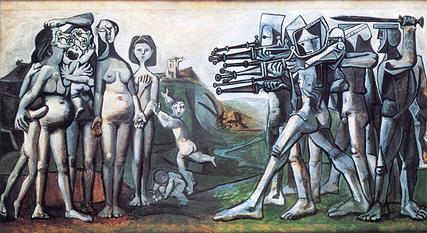
Picasso: Massacre in Korea, 1951.
Death
Pablo Picasso died on 8 April 1973 in Mougins, France, from pulmonary edema and a heart attack, the morning after he and his wife Jacqueline entertained friends for dinner. He was interred at the Château of Vauvenargues near Aix-en-Provence, a property he had acquired in 1958 and occupied with Jacqueline between 1959 and 1962. Jacqueline prevented his children Claude and Paloma from attending the funeral. Devastated and lonely after the death of Picasso, Jacqueline killed herself by gunshot in 1986 when she was 59 years old.
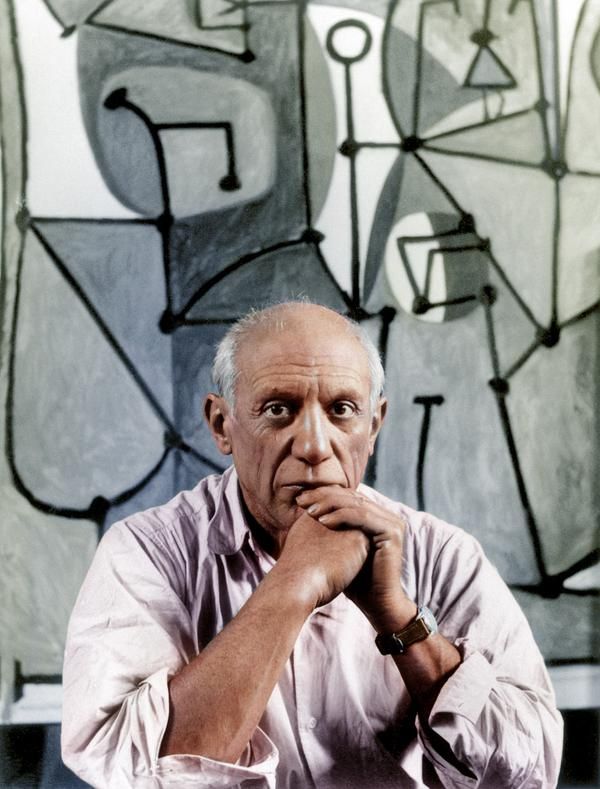
Picasso in his final years.
